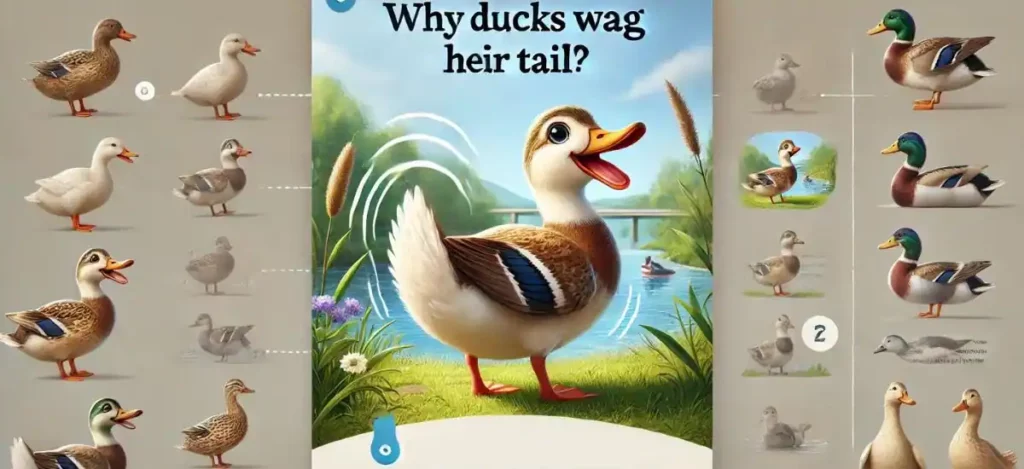Ducks wagging their tails is a behavior that often piques the interest of those who observe these birds in nature. This common but curious gesture is not just a random action; it’s a meaningful form of communication among ducks. Ducks wag their tails for several reasons, including expressing emotions such as joy and excitement, communicating with other ducks, and sometimes indicating stress or discomfort. Understanding the reasons behind tail wagging can enhance our appreciation of these creatures and offers insights into their social behaviors and emotional states.
Decoding Duck Behavior: Basics of Tail Wagging
Ducks, like many animals, communicate a lot through body language. Tail wagging is a significant part of duck behavior that serves various purposes, ranging from expressing emotions to communicating with fellow ducks. Understanding the basics of this behavior not only enhances our bird-watching experience but also deepens our appreciation for these feathered creatures. So, next time you’re out near a waterbody, pay a little more attention to how these ducks are wagging their tails—it’s their way of ‘talking.’
Key Reasons Ducks Wag Their Tails
Emotional Expressions: Joy and Excitement
Just like your furry friend at home might wag its tail when it sees you, ducks often show their glee through tail wagging. During feeding time or when interacting playfully with their peers, ducks frequently exhibit this joyful behavior. It’s a sight that’s sure to bring a smile to anyone’s face!
Communication Among Ducks
Tail wagging also plays a crucial role in the social lives of ducks. It helps maintain group cohesion and serves as a signal in their social interactions, from establishing pecking order to simple acknowledgments among the group. Understanding these subtle cues can turn an ordinary bird-watching session into an insightful exploration of duck dynamics.
Stress and Discomfort Signals
Not all tail wags are happy ones. Sometimes, ducks wag their tails as a sign of discomfort or distress. This can occur in various situations, such as environmental stressors or health issues. Learning to differentiate between a happy wag and a stress signal can provide crucial insights into the wellbeing of these birds.
Observing Duck Behavior: When and Where
If you’re keen on seeing these behaviors in action, the best times to observe ducks are during the early morning or late afternoon when they are most active. Local parks, ponds, and wildlife sanctuaries provide ideal settings for duck watching. Here are a few tips for a fulfilling observation experience:
- Stay Quiet and Unobtrusive: Ducks are more likely to exhibit natural behaviors when they feel safe. Keeping a low profile helps in not disturbing them.
- Use Binoculars: To get a close-up view without getting too close, binoculars are a birder’s best friend.
- Keep a Journal: Recording your observations can be incredibly rewarding. Note the different behaviors and tail wags you witness to track patterns over time.
Comparative Insights: Tail Wagging Across Species
Ducks aren’t the only animals that use tail wagging to communicate. Many animals, including dogs, cats, and even some reptiles, exhibit similar behaviors. By comparing these, we can glean:
- Common Grounds: Many animals wag their tails as a sign of excitement or happiness. This cross-species behavior points to deep evolutionary roots.
- Unique Behaviors: Each species has distinct reasons and methods for tail wagging. For example, while dogs might wag their tails broadly as a clear sign of happiness, ducks might use subtler wags primarily for communication within the flock.
Exploring these similarities and differences not only broadens our understanding of animal behaviors but also highlights the intricate ways in which different species have adapted similar mechanisms for their survival and social interactions.
Frequently Asked Questions
Q1. Can you tell the mood of a duck just by its tail wagging?
Ans: Absolutely! While it’s not the only cue, tail wagging can give us significant insights into a duck’s mood. A relaxed, slow wag often means they’re content, while a rapid flick might indicate excitement or agitation.
Q2. Do all ducks wag their tails for the same reasons?
Ans: Mostly, yes, but context matters. Environmental factors, the presence of other ducks or animals, and their own internal state can influence why a duck wags its tail at any given moment.
Q3. How can I differentiate between a happy wag and a stress wag in ducks?
Ans: A happy wag is usually more rhythmic and accompanies peaceful or playful activities. Stress wags tend to be more erratic and may be paired with other signs of discomfort like vocalizations or escape behaviors.
Conclusion
Tail wagging in ducks is more than just a quirky behavior; it’s a window into their emotional and social lives. By understanding and observing these behaviors, we deepen our connection with nature and foster a greater appreciation for the wildlife around us. So next time you spot a duck, take a moment to observe—it might just be trying to tell you something.

